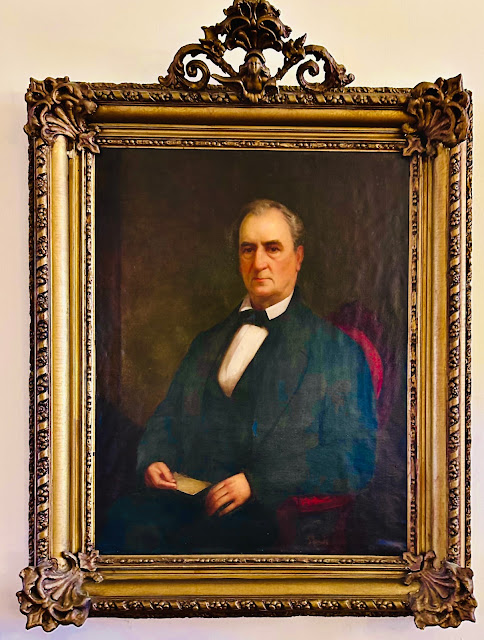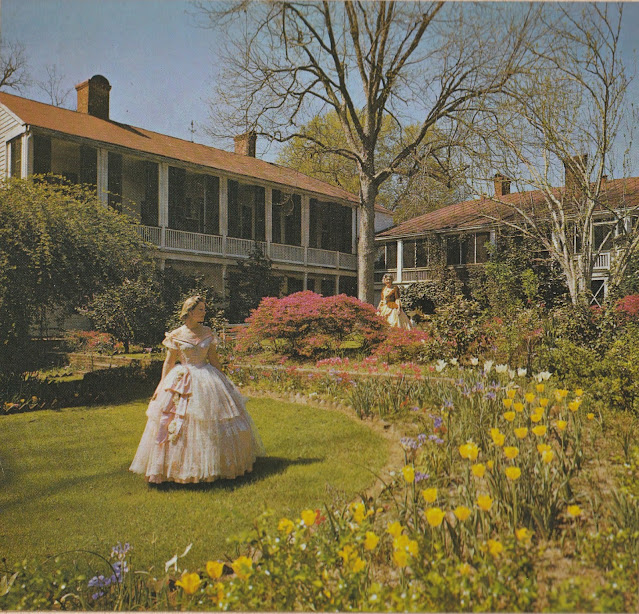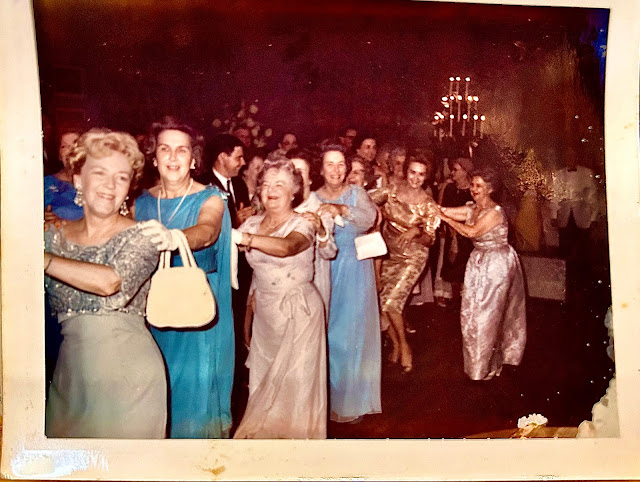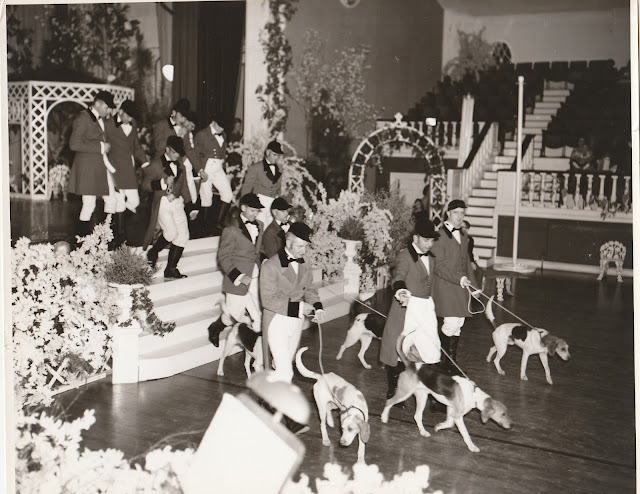 |
| Photo by Michael Chapman |
I've been asked to tell the history of Stanton Hall, but that story can't be told without the story of Natchez. Natchez isn't simply a town to those who've lived their lives here. It's its own character, like in a novel. The people here love this town in ways most people don't understand. Natchez is a member of the family. We all grew together.
We all know that Natchez is the oldest town on the Mississippi River, and also one of the wealthiest enclaves in the country before the Civil War. Having plantations across the river in the Louisiana Delta, wealthy landowners built their townhouses (or McMansions) in Natchez to impress each other and give and go to the best parties in town. It's always about who has the most toys. Stanton Hall is today's billionaire's space tour. Natchez had more millionaires, per capita, than any other city in the US from about 1820 to 1860.
A 2019 article for The New York Times by Richard Rubin states:
"Make your way around Natchez, Mississippi, and you get the sense that if some people ever got really close to living like European aristocrats in the United States, it happened here."
This is the view Mr. Stanton had from the cupola atop Stanton Hall where he could watch his cotton and other cargo arrive and leave on the many steamboats that carried cargo of all kinds. In this photo, you can see arrows pointing out where the barn was and still remains.
Frederick StantonFrederick Stanton emigrated to America from Ireland in 1815, and settled in Natchez after marrying Hulda Laura Helm at her father's home, "The Helms," in Kentucky in 1827. In the intervening years, the Stantons lived somewhere on Main Street, at the house "Cherokee" on High Street, and at "Glenwood" on the outskirts of town.
By 1849, Stanton had acquired enough wealth to build his dream home, which he named "Belfast" in honor of his Irish heritage. He bought an entire city block bounded by High, Pearl, Commerce and Monroe Streets for $1,500.
Captain Thomas Rose
The architect and builder of Stanton Hall was Captain Thomas Rose, a master carpenter from England, who executed the construction using classical Greek-Revival details, but also using the latest Italianate designs to give it its own character. Incidentally, Captain Rose was my great, great, great grandfather.
He utilized the 1835 book by Minard Lafever, The Beauties of Modern Architecture, of which I still have his copy, taken to New Orleans for repair before I learned about this lecture. I've found one other first-edition copy online for almost $1,000.
Rose sent regular bills to Stanton for the work, which eventually totalled $83,262.23. This included furnishing the plans for the house, receiving all the materials, and contracting all the carpentry work, the painting, glazing, varnishing, roofing, plastering and sundry work on the interior and exterior.
Invoice from Robert Stewart, a local cabinetmaker and retailer.
Edgewood
Elms CourtRose also built Edgewood, Elms Court and a number of smaller houses in town. Rose signed his work at Elms Court. I read an article online that Rose had asked Stanton if he could sign his work at Stanton Hall and was refused. The article stated that that is the reason the wrought-iron on the porches and balconies of the house were festooned with roses, a mild rebuke for not being able to sign his name.
This is off topic, but I thought you might enjoy these photos of Elizabeth Taylor at Elms Court during the filming of Raintree County.
Rose killed himself in 1860 just before the war for nonpayment of one of the houses he built, having been bankrupted from that nonpayment. No one believed he was really bankrupt, as is indicated by a diary entry by Natchez planter, scientist and historian B.L.C. Wailes, dated January 1860:
"Mr. Thomas Rose, who has made a fortune in and about Natchez, where he has lived for twenty years or more, as a master mechanic, and who is worth not less than $150 thousand, is on board the General Quitman in the charge of his son and a few friends who are taking him to the lunatic asylum in Jackson, having been deranged by the present political excitement (that sounds like me!) and imagines himself ruined and poor. He is a worthy and industrious and sober man, much esteemed. From the present indications in the political arena, there are thousands among the disunionists more mad than he."
On April 28, 1860, the Reverend Joseph Buck Stratton, minister of the First Presbyterian Church, wrote in his diary that, "... he had been sent for to visit the family of Mr. Thomas Rose, who under derangement of mind, shot himself this evening."
The following are some older photos of Stanton Hall.
Stanton Hall, 1938
Historic view from the front balcony of Stanton Hall
Rear view of Stanton Hall
Ladies on the upstairs balcony, which shows the scale of the house. Photographer unknown.
Blueprint for Stanton Hall
Frederick Stanton only lived in his beloved "Belfast" for about a month before dying of chronic liver inflammation at the age of 65 in 1859.
Quoting President Emeritus of the Historic Natchez Foundation, Mimi Miller:
"Most Natchez fortunes were wiped out by the Civil War; but Natchez, itself, was spared largely because Natchez voted against secession.
"Not that its elite were opposed to slavery -- most of their fortunes were built on cotton, and thus, on slave labor ,"-- but as Mimi put it, "the town's leading citizens recognized that secession was bad for business -- and crazy."
For the next 34 years, the house was occupied by his widow, Hulda and other Stanton family members. In 1893, Hulda died of apoplexy, which probably meant a stroke. The opulence and size of the house made it a great financial burden on his heirs.
In 1894, Stanton's heirs divided the furnishings and sold the house to the Stanton College for Young Ladies. The college occupied the house until the early 1900s when it was relocated to the nearby home "Choctaw," where it remained until it closed in 1915. Trinity School did the same thing when it moved into the mansion "Magnolia Hall" before building a proper school on the outskirts of town.
Girls at Stanton College in front of Choctaw. From left: Ethel Brandon, Annet Pritchartt (my great aunt). According to artist Noah Saterstrom, Ethel marked the other two as Bertha and Lots.
Annet Pritchartt's report card from Stanton College for Ladies
I also have a yearbook from Stanton College, "The Tadpole," which I also took to New Orleans to be repaired or I'd have brought it with me.
In the early 1900s, the house was again occupied by family members, Mr. and Mrs. A.G. Campbell
In 1917, the house was sold to Luther Childs, and in 1920, was sold to R.T. Clark, who lived there with his family until 1938 when it was bought by the Pilgrimage Garden Club for use as its club headquarters. It remains with the PGC, which uses it as its headquarters, and operates it as a museum, event venue and clubhouse. The club bought Stanton Hall, along with the entire block for $16 thousand. Every woman in the club signed the mortgage, along with their husbands, who also signed in order to guarantee the loan.
Aside from certain gasoliers, mirrors and a smattering of original furniture, the house was essentially empty when the club acquired it, so they pulled together to refurnish it.
Just as the ladies of Natchez had pulled together to create the Pilgrimage, they did the same for Stanton Hall, donating many of their own pieces of silver, crystal, furniture, etc. It wasn't original, and it wasn't necessarily period, but through the years and a lot of research, they've managed to bring the house closer to its original decor, including Stanton family pieces that were returned to the home by family members and their descendants.
Original furnishings when the Stantons lived there.
Interior designer and antiques dealer, Earlhart Miller, helped them. It was he who installed the Zuber wallpaper in the upstairs hall, which, while not original to the house, is certainly beautiful.
According to Mrs. Bettye Jenkins, who lives at Hawthorne, Stanton Hall was in good shape when they bought it. They never had to do too much to it, but it was empty.
"There was a great debate on whether the gold drapes in the downstairs were appropriate," said Mrs. Jenkins.
"I don't remember how long the debate went on, but it was a big to-do. There was nothing wrong with the gold drapes, but they were correct in that they were originally red."
Margaret Martin, a Stanton descendant who had lived at Stanton Hall, found a panel of red draperies in her attic that had been originally installed in the house. That answered the question, so the panel was sent to Schumacher Fabrics to recreate the material for the drapes.
"We had a lot of people who were very generous," Mrs. Jenkins said. Some people gave money; some gave their own furniture and other decorative objects. When we had to make a repair, we were always limping around asking for money for Stanton Hall."
It was this devotion to Natchez that gave birth to the Pilgrimage. It was 1930 and the boll weevil had decimated the cotton crop, which was during the Great Depression, which was on the heels of World War I, which was on the heels of Reconstruction, which was on the heels of the Civil War.
Even though Natchez had suffered through the same hardships as the rest of the world, so recently removed from wealth beyond imagining, it remained steadfast, and life -- though harder -- carried on with its card clubs, sewing circles, garden clubs, cocktail parties (Bathtub gin until prohibition ended), book clubs and get togethers.
Legend has it that in 1931, The Natchez Garden Club (as it was then called), hosted a state garden club convention in Natchez to highlight what was left of the formal gardens at their estates. It's commonly told that there was an unexpected freeze; thus, the garden tours moved inside, where the visitors were stunned at the beauties they beheld.
In an interview by Elliott Trimble (I believe), Katherine Miller stated that there was no freeze. According to her, they had been planning to open the houses for several years, and the newspapers that day showed the weather as fair and clear.
But the gardens were, indeed, neglected, so the house tours became the main attraction.
It's easy for us to think The Pilgrimage was simply a local effort; however, if you learn what they did to bring it about, you realize how brilliant and brave these women were.
Katherine Miller couldn't have children and was in the hospital recovering from a difficult surgery when the nurses told her that all she talked about during her delirium was Azaleas and Camellias and gardens. With no children, it was she who was chosen to do the monster task of getting the word out. And it WAS a monster task.
A portrait of Katherine Miller, painted by M.Ciani, an Italian painter who became a portraitist for Presidents and Royals. It is also interesting to note that Katherine was the great granddaughter of Captain Thomas Rose.
This painting was, unfortunately destroyed in the recent fire at Katherine's home, Hope Farm.
This was the early 1930s when women stayed home and raised families. But Katherine went to radio stations not only here in Natchez, but all over the country and talked about Natchez and the treasures it held. She spoke to garden clubs (including the National Garden Club), Kiwanis, Rotary, Moose Lodge...anyone who would listen. She traveled by herself on trains to places as far reaching as New York and California, alone. We're used to women traveling alone today, but in the 1930s it was unheard of.
She hired a photographer to take photographic glass slides of all the antebellum homes in town, and took what was called a Magic Lantern, which worked like a slide projector except it was lit from behind by a candle. The slides and lantern are now safely ensconced at the Mississippi Archives in Jackson, MS.
She convinced train companies to offer special discount rates to tourists, who would otherwise be unable to afford the trip.
The ladies helped the City when it was recruiting industry by hosting visiting executives. I do know that at one point, Katherine went to the head of International Paper Company to ask them to stop production during the month of pilgrimage because of the smell, which is similar to boiling broccoli. Needless to say, her request went unheeded.
She placed ads in newspapers all over the country, becoming a master at marketing.
Meanwhile, Natchez women were cleaning their houses and perfecting their gardens, and what splendid gardens they were.
The gardens behind Mrs. Miller's house, Hope Farm.
Those ladies were fierce and bossy and resplendent in their Grandmother's hoopskirts, and knew how to work hard and to play hard.
One funny story about cleaning homes was that of Mrs. Alma Kellog at The Elms. Every spring before opening her house, she waltzed about the house spraying the air with Lemon Pledge. Tourists would arrive and exclaim, "You can sure tell this house has been cleaned from top to bottom. Just smell that lemon."
Mrs. Ruth Audley Beltzhoover of the home "Green Leaves," and Mrs. Alma Kellogg of "The Elms."
The Elms, photographer unknown
The first Pilgrimage was a parade of Antebellum ladies and scenes downtown. Once the homes were opened there was no stopping them. It was more successful than they could have imagined. These women saved Natchez from ruin during the hard years of the Depression and World War II, and tourism remains the number-one industry in Natchez today.
During World War II, Stanton Hall hosted dances for the troops stationed nearby, which also raised money for Stanton Hall.
This was the nascence of cultural tourism in this country. Stanton Hall hosted overnight guests, as did Katherine Miller, who hosted the Attorney General and Ladybird Johnson during the 1970s.
"We did do B&B for a short time at Stanton Hall in the 40s," said Mrs. Jenkins, "...but it proved to be too much trouble. People smoked back then and one man hung his clothes on one of the priceless gasoliers in the back bedroom, causing it to fall out of the ceiling and crash. The bathrooms weren't ideal either."
Because it was a club, they installed a swimming pool for members and their families. I learned to swim in that pool and had a huge crush on the teenaged lifeguard who taught me how to swim.
.jpg)

The women of Natchez hosted tea parties at their homes, particularly at "Green Leaves" on the back patio.
Rear Entrance at Green Leaves where tourists were treated to tea parties on the patio.
After tours, each guest was presented with a rare Camelia Japonica, which delighted them no end.
The tourists who visited wore their best clothes, as though they were attending church, but this was more fun. Donning the latest fashions in hats, suits and gloves, they lined up to take a peek at how the other side used to live.
Katherine Miller receiving tourists at Hope Farm. Notice the cigarette she's holding.
Before long, the ladies realized they needed to provide some nighttime entertainment for the tourists. Thus, the Confederate Ball Tableaux was born. It was also known as the Confederate pageant. In a blog post I wrote about 17 years ago, I explained:
"For over sixty years, [Katherine] ruled Natchez society, engendering fear, admiration, adoration and loathing in equal measure. Under her direction, grown men were persuaded to dress up like Southern planters and dance The Soirée for strangers. They even allowed their wives to smear rouge and lipstick on their sons, and dress them in lace and knickers and ballet shoes to dance around a Maypole with little girls in hoopskirts.
"Sure, for the rest of the year, they wore camouflage, slapped each other on the back, broke wind, hunted wild game, played and talked football and discussed the price of oil.
"But March belonged to the women. No disgrace was too demeaning to keep them from following the orders of the matriarchs of Natchez.
The reason it was called The Tableaux, which is plural for Tableau. From Wikipedia: A tableau is a French word that means a picture, painting, or representation. It can also refer to a vivid or graphic description of a scene or a striking or artistic grouping of persons or objects. Sometimes, tableeau is used to describe a depiction of a scene on a stage by silent and motionless, costumed participants. The word comes from Old French "table," meaning "slab," or "writing tablet."
It was a simpler time back then, and the people of the day often performed tableaux for Mardis Gras and other celebrations, so it stood to reason that this was how they would entertain the tourists at night.
All the locals took part in it, rehearsing over and over for months before March. Each stationary tableau ended with the participants descending from the stage and walking through the front double doors of the auditorium (a Pageant), so people could get a good look at the talent and skills of the women who designed the costumes, which were breathtaking and mostly taken from old copies of Godey's Lady's Book, which was a women's magazine published from 1830 to 1878.


There were two ballets, which later gave way to more. The most popular ballet was one choreographed and created by local dance teacher Martha Hootsell. Mrs. Hootsell's most outstanding dancer was chosen each year to play the part of artist John James Audubon, who lived in Natchez for a short while and taught dance while here. Our own Courtney Stacy Taylor danced Audubon one year and did it justice.
The different scenes and tableaux were accompanied by a small, live orchestra, playing piano, cello, violins, etc. It was a magical time.
The program ended with the raising of the American flag and the entire audience as well as players stood to sing the Star-Spangled banner.
All of this was done out of love of family, of friends, neighbors, country, history (and, admittedly, money). These ladies really left a legacy that needs to be continued. As one member said to me, "It is up to us now to take up the mantle of these amazing women and continue to make Natchez one of the most unusual and beautiful small towns in the now United States.
They women went all out, making backdrops and creating azaleas out of crepe paper and hanging moss and Magnolia leaves. I could speak more about all of this, but I know you're hungry and ready to eat the fine lunch that our chef Wayne Bryant has prepared for us.
The following is an array of photographs from the Tableaux.
This tableau is called The Hunt, and I have one or two funny stories to tell about it. (See below)
My father told me that one of his fondest memories is of his best friend, Johnny Ogden, sneaking into the City Auditorium the afternoon before the pageant with a dead fox he'd found beside the road. Dragging the fox by the tail, Johnny made his way up and down the aisles, over and under the seats of the room, laying down a scent and then slipping back outside.They roared with laughter that evening when during the tableau for The Hunt, the beagles and hounds used for the scene broke their leads and climbed across horrified tourists' laps, baying loudly, drooling, trembling, and peeing with excitement, as they tracked the scent of the long-departed fox.
And there was also the occasional dog poo that had to be cleaned up between acts.
So here's to the Pilgrimage Garden Club. For information on tours and trips, please visit natchez.org and natchez.com and visitnatchez.org.












































.jpg)


















No comments:
Post a Comment